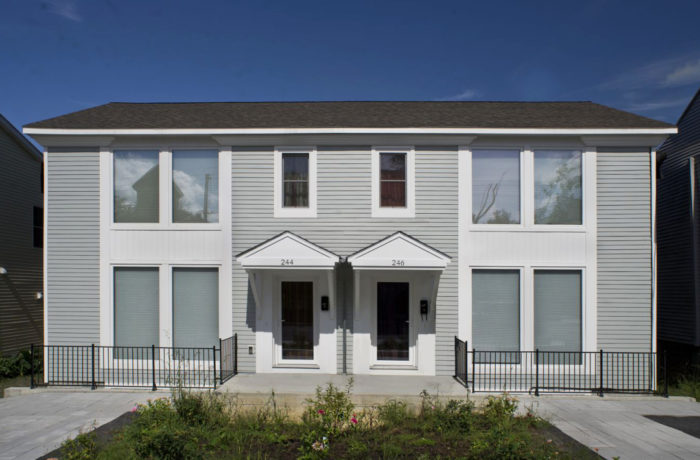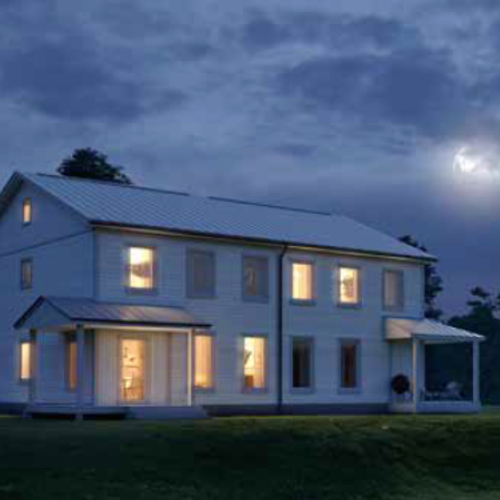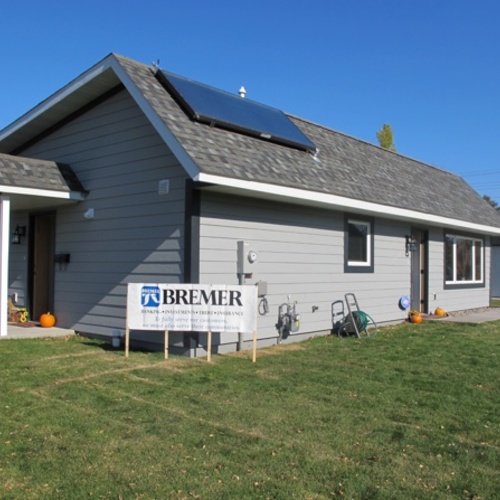Image Credit: BarlisWedlick Architects
Image Credit: BarlisWedlick Architects It doesn't look like 'affordable housing.' The interior of the Hudson, N.Y., Habitat project is bright, clean, and contemporary. The project was designed by BarlisWedlick Architects, which donated its services.
Image Credit: BarlisWedlick
An upstate New York Habitat for Humanity chapter was already committed to energy-efficient design when it began mulling over the possibility of a project built to the Passivhaus standard — maybe not right away, mind you, but some time in the future. Then executive director Brenda Adams ran into a celebrated architect who had just wrapped up his first Passivhaus project. “What are you waiting for?” he asked her.
The result of the ensuing collaboration between the Columbia County Habitat chapter in Hudson, New York, and architect Dennis Wedlick and his firm was a two-unit town house. It didn’t quite meet requirements for Passivhaus certfication, but Adams is convinced that energy-efficient design is the future of affordable housing, and the chapter already has broken ground on its second Passivhaus project. A third is in the pipeline for next year.
Adams said that Habitat had been drawn to the Passivhaus standard because the standard had the potential to overcome one of the principal challenges to home ownership for people who don’t earn a lot of money: high energy costs. Wedlick, whose firm BarlisWedlick has offices in both Hudson and New York City, had recently completed the state’s first Passivhaus project, and his nudge was all it took.
Wedlick and his partner Alan Barlis donated their services, and together they worked with the Habitat chapter to plan the project.
It was a “tremendously positive experience,” Adams said.
Close but no cigar on certification
The 1,200-square-foot Hudson townhouses (1,614 square feet each if the conditioned basements are included) have double stud exterior walls that are insulated to R-42 with blown-in cellulose. The main roof is trussed; it is insulated to R-87. The slab is insulated to R-56.
This year’s project, Adams said, is a hybrid that combines stick construction with structural insulated panels (SIPs). Next year’s project will be an all-SIP design.
Habitat’s real goal, she said, is the development of a template for affordable housing that can deliver predictable results.
Columbia County (population, 60,000) is south of the New York capital on the Hudson River. The chapter now builds two houses per year, although Adams said she hoped that number would grow in the future.
The townhouse project was a “small but mighty” first step. Adams said that the building’s performance has been measured since completion. Adams said the townhouses performed better than planners had expected despite a cold winter.
But Passivhaus certification was not in the cards. The project just squeaked by on the blower-door test for air-tightness, at 0.59 air changes per hour at a pressure difference of 50 pascals (the limit is 0.6 ach50). But air-flow problems with the ventilation system prevented the project from meeting all of the certification requirements, according to Jordan Dentz of the The Levy Partnership, which did field testing on the project. Levy Partnership also donated its time.
Other project details
Each three-bedroom, 1 1/2-bath townhouse cost about $125,000 and required 4,000 hours of volunteer labor, according to an article about the project in Builder. Money to build the units came from a variety of sources. The city of Hudson donated the infill lot.
Other details, as provided by Barlis/Wedlick and The Levy Partnership:
- Domestic hot water: Electric storage tank model.
- Heating and cooling: One ductless minisplit heat pump per side unit.
- Windows: triple-glazed Intus units with solar heat gain coefficients ranging from 0.37 to 0.62 and center-of-glass U-factors ranging from 0.09 to 0.123.
Habitat chapters around the country make their own decisions about the projects they undertake. A relatively small number of them have decided to build high-performance housing, either net-zero energy or Passivhaus, but about three-quarters of all new Habitat housing meets Energy Star guidelines.
Weekly Newsletter
Get building science and energy efficiency advice, plus special offers, in your inbox.
















0 Comments
Log in or create an account to post a comment.
Sign up Log in